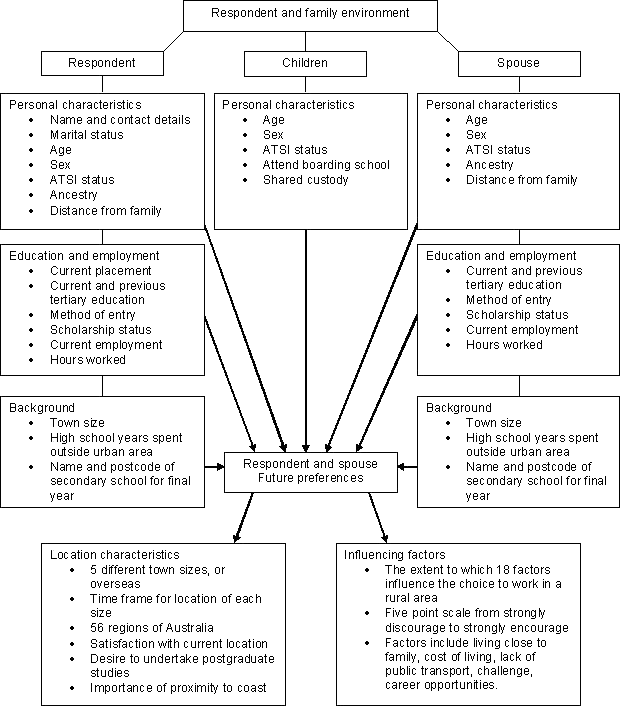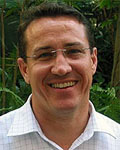Introduction
Limited access to health services remains a significant problem for people living in rural and remote areas of Australia1-4. This is in part due to difficulties in attracting and retaining health professionals to rural practice5-9. Schemes devised to improve the recruitment and retention of the rural health workforce1-3,5,10-14 will only be successful over the long term if they address the issues that are important to health students in deciding to work in a rural or remote area, and target the students most likely to work in such areas3.
The literature has identified a number of factors which can influence clinicians in making location decisions, including rural background1,3,4-6,15-21 or training1,3-5,15,17,20,22,23, spousal background1,17,19, sex1,5,24, specialisation, as well as the availability of professional support and continuing medical education3,6,9,16.
The current study is unique in that it includes all health disciplines, takes account of immediate and extended family factors that impact on employment preferences, and is longitudinal in design. It should enable researchers to follow student decisions about where they commence practice, when and if they practise in a rural area, and the association with factors that are a positive or negative influence on choosing to work in a rural area. It will examine factors that influence both recruitment, as students first move into the workforce and make their location choices, and retention as the new health professionals become settled in their career over time and make decisions to stay or leave their initial work location. This article takes a similar approach to that of DeWitt and her colleagues25, in that it describes the development and content of the survey tool.
Method
The Careers in Rural Health Tracking Survey (CIRHTS) was developed following a review of relevant literature and existing surveys, consultation with rural clinicians, and piloting a draft instrument with students undergoing rural placements. Some questions (such as questions 13, 14, 17 and 21; Appendix) were taken or modified from previously published questionnaires in order to make the survey comparable with other data sources25,26.
Approximately 500 students per year are anticipated to complete the survey while on rural placement at the Northern Rivers University Department of Rural Health, New South Wales, Australia. The placement experience can differ among disciplines, universities, and year of study. The CIRHTS, therefore, has the potential to examine the impact of repeated versus one-off, and early versus late exposure to rural practice, and the relationship between length of placement and rural uptake for different health professions.
Once recruited into the study, participants in each cohort will be followed for at least 10 years using an annual questionnaire. Cohorts will consist of students having a rural placement in a given year, with students continuing to be recruited over the life of the study. Once in the workforce, in future waves of the study, participants will receive a modified version of the survey instrument, which will enable examination of changes in preferences over time, and will also gather information on their experiences as new health professionals, including both work and continuing education issues.
The questionnaire was completed and final ethics approval was received from the University of Sydney Human Research Ethics Committee in 2006.
Results
The CIRHTS survey (Appendix I) questions students in detail on their personal characteristics, family relationships, education and current employment, employment preferences and factors influencing those preferences, and rural background (Fig 1). Because the decision to move to a rural area may also involve a partner or spouse, most items have space for both student and spouse responses.

Figure 1: Components of respondent and spouse characteristics.
Understanding the time dimension in a person's decision-making is crucial when developing initiatives to attract clinicians to rural practice. The CIRHTS is unique in that it asks students not only what size towns they would be willing to work in, but also when they might work there. For example, a student could indicate that they would work in a rural community within one year, a major urban centre within 5 years but never overseas.
While previous research has often distinguished only between rural and urban locations, pilot data for the current study suggested that the distinction is not so simple. It could be expected that when students consider practising in a 'rural area', their mental model of 'rural' is not defined as 'outside a capital city', but rather includes a variety of settings, some of which they would be willing to work in and others they would not.
Thus, CIRHTS asks participants to nominate exactly which regions of Australia they would work in and, in so doing, attempts to define areas of Australia in terms of general desirability for practice location, to identify the types of clinicians who are motivated to work in particular regions, and to characterise the positive and negative factors that go into a decision to practise in one area versus another. Maps based on the Australian Bureau of Statistics' Australian Standard Geographical Classification of regions27 are provided to assist students and partners in completing this section of the survey.
One important distinction among types of rural areas is the distinction between coastal and inland areas. With more Australians than ever before looking to live and work on the coast6,28, it is important to know whether this preference is equally reflected by young health professionals. Accordingly, CIRHTS identifies students for whom working near the coast is important, as well as those for whom it is not.
To ascertain the main drivers in student and partner location preferences, participants are asked to quantify on a Likert scale the extent to which certain factors would influence their decision to work in a rural area, from 'strongly discourage' to 'strongly encourage'. Space is also provided for respondents to name any factors that are not already listed.
Conclusions
The CIRHTS has the potential to collect a great deal of information on medical, nursing, and allied health students' regional preferences, and the issues they consider important when considering rural practice. By collecting this information and tracking students over time, it should be possible to identify the specific factors, and respective weights of each factor, that determine whether an individual will be motivated to choose rural practice. This knowledge may be particularly useful for government and industry when developing new schemes so that they provide the greatest incentive for rural practice.
Acknowledgments
The authors thank the student coordinators for their assistance in developing the survey and in keeping the project running: Vanessa O'Rourke and Shelley Hermann in Lismore, Jane Nichols in Grafton and Naree Hancock in Murwillumbah.
References
1. Laven G, Beilby J, Wilkinson D, McElroy H. Factors associated with rural practice among Australian-trained general practitioners. Medical Journal of Australia 2003; 179: 75-79.
2. Humphreys J, Jones J, Jones M, Hugo G, Bamford E, Taylor D. A critical review of rural medical workforce retention in Australia. Australian Health Review 2001; 24: 91-102.
3. Rolfe IE, Person SA, O'Connell DL, Dickinson JA. Finding solutions to the rural doctor shortage: the roles of selection versus undergraduate medical education at Newcastle. Australian and New Zealand Journal of Medicine 1995; 25: 512-517.
4. Hays RB, Nichols A, Wise A, Adkins P, Craig M, Mahoney M. Choosing a career in rural practice in Queensland. Australian Journal of Rural Health 1995; 3: 171-174.
5. Wilkinson D, Laven G, Pratt N, Beilby J. Impact of undergraduate and postgraduate rural training, and medical school entry criteria on rural practice among Australian general practitioners: national study of 2414 doctors. Medical Education 2003; 37: 809-814.
6. Shoo AM, Stagnitti KE, Mercer C, Dunbar J. A conceptual model for recruitment and retention: allied health workforce enhancement in Western Victoria, Australia. Rural and Remote Health 5: 477. (Online) 2005. Available: www.rrh.org.au (Accessed 1 July 2006).
7. Richards HM, Farmer J, Selvaraj S. Sustaining the rural primary healthcare workforce: survey of healthcare professionals in the Scottish Highlands. Rural and Remote Health 5: 365. (Online) 2005. Available: www.rrh.org.au (Accessed 1 July 2006).
8. Reamy J. Physician recruitment in rural Canada: programs in New Brunswick, Newfoundland, and Nova Scotia. Journal of Rural Health 1994; 10: 131-136.
9. Bushy A, Leipert B. Factors that influence students in choosing rural nursing practice: a pilot study. Rural and Remote Health 5: 387. (Online) 2005. Available: www.rrh.org.au (Accessed 1 July 2006).
10. Humphreys J, Hegney D, Lipscombe J, Gregory G, Chater B. Whither rural health? Reviewing a decade of progress in rural health. Australian Journal of Rural Health2002; 10: 2-14.
11. Adams M, Dollard J, Hollins J, Petkov J. Development of a questionnaire measuring student attitudes to working and living in rural areas. Rural and Remote Health 5: 327. (Online) 2005. Available: www.rrh.org.au (Accessed 1 July 2006).
12. Jones JA, Humphreys JS, Adena MA. Rural GPs' ratings of initiatives designed to improve rural medical workforce recruitment and retention. Rural and Remote Health 4: 314. (Online) 2004. Available: www.rrh.org.au (Accessed 1 July 2006).
13. Butler C, Sheppard L. The impact of undergraduate rural education on recently graduated physiotherapists. Australian Journal of Physiotherapy 1999; 45: 23-30.
14. Hegney D, McCarthy A, Rogers-Clark C, Gorman D. Why nurses are attracted to rural and remote practice. Australian Journal of Rural Health2002; 10: 178-186.
15. Eley D, Young L, Shrapnel M, Wilkinson D, Baker P, Hegney D. Medical students and rural general practitioners: congruent vies on the reality of recruitment into rural medicine. Australian Journal of Rural Health 2007; 15: 12-20.
16. Heaney S, Tolhurst H, Baines S. Choosing to practice in rural dietetics. What factors influence that decision? Australian Journal of Rural Health 2004; 12: 192-196.
17. Tolhurst HM, Adams J, Stewart SM. An exploration of when urban background medical students become interested in rural practice. Rural and Remote Health 6: 452. (Online) 2006. Available: www.rrh.org.au (Accessed 1 July 2006).
18. Ward AM, Kamien M, Lopes DG. Medical career choice and practice location: early factors predicting course completion, career choice and practice location. Medical Education 2004; 38: 239-248.
19. Rabinowitz HK, Diamond JJ, Hojat M, Hazelwood CE. Demographic, educational and economic factors related to recruitment and retention of physicians in rural Pennsylvania. Journal of Rural Health 1999; 15: 212-218.
20. Woloschuk W, Tarrant M. Does rural education experience influence students' likelihood of rural practice? Impact of student background and gender. Medical Education 2002; 36: 241-247.
21. Woloschuk W, Tarrant M. Do students from rural background engage in rural family practice more than their urban-raised peers? Medical Education 2004; 38: 259-261.
22. Eley D, Baker P. Does recruitment lead to retention? Rural Clinical School training experiences and subsequent intern choices. Rural and Remote Health 6: 511. (Online) 2006. Available: www.rrh.org.au (Accessed 1 July 2006).
23. Brooks RG, Walsh M, Mardon RE, Lewis M, Clawson A. The roles of nature and nurture in the recruitment and retention of primary care physicians in rural areas: a review of the literature. Academic Medicine 2002; 77: 790-798.
24. Scammon DL, Williams SD, Li LB. Understanding physicians' decisions to practice in rural areas as a basis for developing recruitment and retention strategies. Journal of Ambulatory Care Marketing 1994; 5: 85-100.
25. DeWitt DE, McLean R, Newbury J, Shannon S, Critchley J. Development of a common national questionnaire to evaluate student perceptions about the Australian Rural Clinical Schools Program. Rural and Remote Health 5: 486. (Online) 2005. Available: www.rrh.org.au (Accessed 1 July 2006)
26. Committee of Deans of Australian Medical Schools (CDAMS). Medical Schools Outcomes Database project 2005: Commencing Medical Students Questionnaire. (Online) 2007. Available:
http://www.medicaldeans.org.au/msod_files/2005_questionnaire.pdf (Accessed 7 January 2007).
27. Australian Bureau of Statistics. Australian Standard Geographical Classification (ASGC), 2005. ABS cat. no. 1216.0. Canberra: ABS, 2005.
28. Salt B. The big shift. Melbourne, VIC: Hardie Grant Publishing, 2005.
-------------------------
Appendix I
Careers in Rural Health Tracking Survey (CIRHTS) survey instrument

Modified 8 January 2008: A sentence has been added to the Method section: 'Some questions (such as questions 13, 14, 17 and 21; Appendix) were taken or modified from previously published questionnaires in order to make the survey comparable with other data sources25, 26.' In addition, an additional reference has been inserted into the reference list as reference 26.








